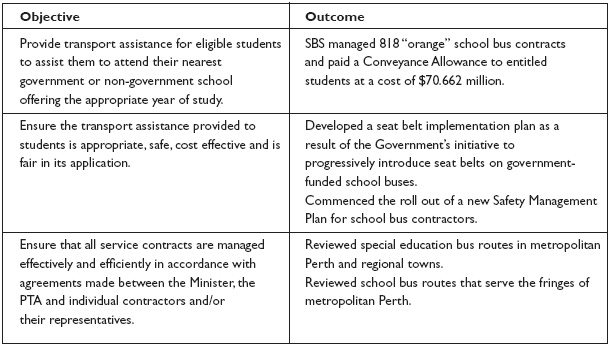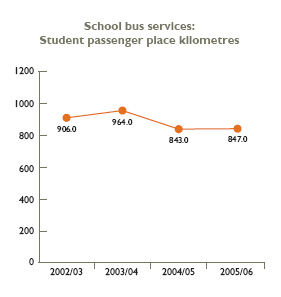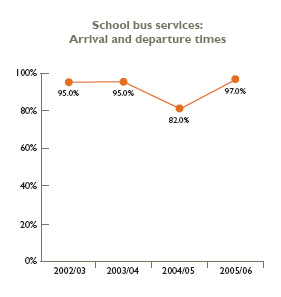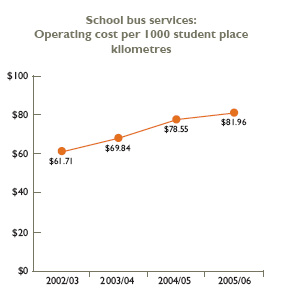
School Bus Services
Introduction
School Bus Services (SBS) Branch is located within the Transperth, Regional and School Bus Division of the PTA, and manages Government student transport assistance. This is predominantly provided using contracted “orange” and “green” school buses around the State. Alternatively, where eligible students cannot be accommodated on a school bus, their parents/carers are paid a Conveyance Allowance to help meet some of the costs incurred by them in getting their children to their nearest appropriate school.
In 2005/06, transport support organised by SBS was used by 24,000 students per school day.
SBS managed 818 school bus contracts/services and paid a Conveyance Allowance to entitled students at a total cost of $70.662 million for Grants and Subsidies. It also provided transport assistance to students attending special education schools principally in large regional towns and in metropolitan Perth.
The school bus network comprised 697 school buses servicing mainstream schools, 114 school buses servicing special education schools, centres and units and seven Regular Public Transport service arrangements.
All “orange” school buses are operated by private contractors.
Three contract/service models were used to provide student transport support:
Composite Rate Model (CRM) Contracts (20-30 years in duration): 694
Fixed term Contracts (Tendered over 1-15 years since 1995): 117
Regular Passenger Transport (Licence arrangement with fare subsidy): 7
The Composite Rate Model is an average cost model which was implemented in January 2004 and provides for contractor payments to be reviewed by an independent review panel.
Statement of Objectives
In 2005/06, the objectives and outcomes of School Bus Services were:

Service

The increase in the use of school bus services is measured by comparing the annual number of student bus service place kilometres.
Student passenger place kilometres for 2005/06 showed a slight increase over the previous year.

Service reliability measures school bus timetable reliability for the rural mainstream services and Education Support School Buses operating in the Perth metropolitan area. The reliability measure is arrival less than 10 minutes before school starts and departure less than 10 minutes after school finishes.
In 2005/06, reliability was back above the acceptable level of 90%.
The cost efficiency indicator for school bus services measures the cost of place kilometres provided to meet student requirements.

The increase in 2005/06 was a result of higher operational costs such as drivers’ wages and fuel.
The Year’s DevelopmentsIntroduction of Seatbelts on School Buses
The State Government announced on 6 November 2005 that WA would be the first state in the nation to ensure seat belts were installed on all dedicated school buses contracted to the State Government. The policy will require from 2006 that all new government-funded school bus contracts must be operated with buses that are fitted with seat belts. In addition, where economically viable, all existing government-funded school buses will be retro-fitted with seat belts. Where it is not economical to retro-fit seat belts on school buses, the buses will be replaced.
In the last six months of the financial year, SBS rolled out 23 new school buses fitted with seatbelts. These complemented the existing 46 Toyota “Commuters” which are fitted with seat belts and already operating on WA roads.
SBS liaised closely with the WA Department of Education and Training to develop a communication strategy to ensure all students who travel on school buses actually wear the seat belts provided for them. In addition, a student code of conduct was being developed to monitor and act on non-compliance by students. SBS sees compliance with the code as vital to ensure students remain safe. It will work with school bus contractors and the department to ensure there is a high level of compliance.
Review of School Bus Services
SBS continued its review process for school bus services in order to provide the most efficient use of public funds, balanced against high-quality and safe transport services for eligible students.
During 2005/06, locations reviewed were Dumbleyung, Northampton, Mukinbudin, Ongerup, Eastern Hills/Wundowie and College Row Education Support School, Bunbury. The actions to follow these reviews are the adjustment of routes and the change of bus sizes to match the demographics of the area.
In some cases, school bus services were closed where there were fewer than four students, in accordance with student transport policy, or where school closures meant services were no longer required. In all cases, these changes were in the Wheatbelt where student numbers have generally continued to decline. The affected services were:
|
Newdegate South East Mount Magnet Cue Mukinbudin Wialki |
Mount Walker South Ongerup North West Eastern Hills Mundaring Weir |
The review of services also resulted in a number of new temporary or short term services being introduced in areas of rural population growth (i.e. Albany, Australind, Gingin-Bindoon, Comet Bay, Little Grove, Frenchman Bay, Quairading, Fitzroy Crossing Wamali, Wananami Dodnun, Wandering), and also some growth of special education in metropolitan Perth and regional towns (i.e. Mandurah, Rockingham, College Row Bunbury Education). In addition, two new “English Second Language” School Bus Services (Federally funded) were commenced in Mirrabooka and Nollamara.
SBS undertook a review of its school buses operating around Geraldton as part of the introduction of a designated Public Transport Area to better reflect the operation of intra-town services. SBS also implemented some modified bus routes as part of the introduction of the Esperance Public Transport Area. The modified services began in term 4 in 2005.
Customer Satisfaction
SBS does not measure customer satisfaction as transport assistance is provided on an entitlement basis.
Expenditure
SBS’s expenditure for 2005/06 was $74.470 million.
In the Future
Changes in the Government’s policy direction and new initiatives by the WA Department of Education and Training such as retention of children at secondary school and potential changes to the compulsory education age will affect SBS in its delivery of student transport assistance over the next three years.
SBS continues to liaise with the department to ensure a whole-of-government approach is taken to clearly identify the financial implications and the impact on student transport assistance.
Objectives for 2006/07
- Continue implementation of seat belts on all Government funded school buses by 2010 in accordance with Government policy.
- Continue review of school bus routes to maximise service delivery and efficiencies in rural Western Australia and Metropolitan Perth.
- Continue liaison with the Department of Education and Training to review student transport assistance policy with regards to:
- integration of students with special needs into mainstream schools
- compulsory school attendance to Year 12 (2008)
- integration of vocational studies into school curriculum through increased usage of TAFE facilities
- implementation of student seat belt compliance policy
- reviewing transport provision when school facilities are opened or closed


